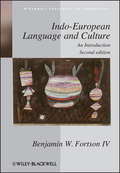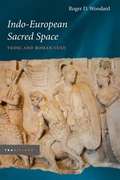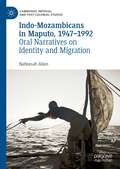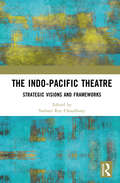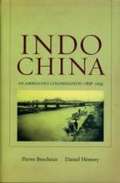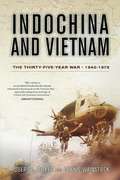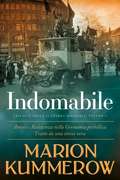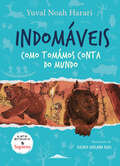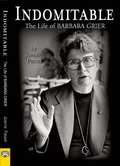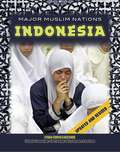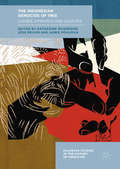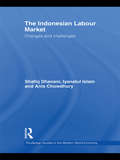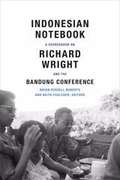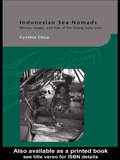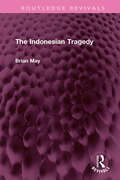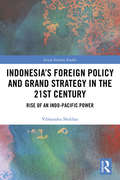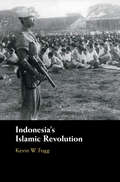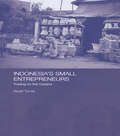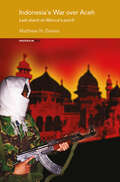- Table View
- List View
Indo-European Language and Culture: An Introduction (Blackwell Textbooks in Linguistics #30)
by Benjamin W. Fortson IVThis revised and expanded edition provides a comprehensive overview of comparative Indo-European linguistics and the branches of the Indo-European language family, covering both linguistic and cultural material. Now offering even greater coverage than the first edition, it is the definitive introduction to the field. Updated, corrected, and expanded edition, containing new illustrations of selected texts and inscriptions, and text samples with translations and etymological commentary Extensively covers individual histories of both ancient and modern languages of the Indo-European family Provides an overview of Proto-Indo-European culture, society, and language Designed for use in courses, with exercises and suggestions for further reading included in each chapter Includes maps, a glossary, a bibliography, and comprehensive word and subject indexes
Indo-European Sacred Space: Vedic and Roman Cult
by Roger D. WoodardIn Indo-European Sacred Space, Roger D. Woodard provides a careful examination of the sacred spaces of ancient Rome, finding them remarkably consistent with older Indo-European religious practices as described in the Vedas of ancient India. Employing and expanding on the fundamental methods of Émile Benveniste, as well as Georges Dumézil's tripartite analysis of Proto-Indo-European society, Woodard clarifies not only the spatial dynamics of the archaic Roman cult but, stemming from that, an unexpected clarification of several obscure issues in the study of Roman religion. Looking closely at the organization of Roman religious activity, especially as regards sacrifices, festivals, and the hierarchy of priests, Woodard sheds new light on issues including the presence of the god Terminus in Jupiter's Capitoline temple, the nature of the Roman suovetaurilia, the Ambarvalia and its relationship to the rites of the Fratres Arvales, and the identification of the "Sabine" god Semo Sancus. Perhaps most significantly, this work also presents a novel and persuasive resolution to the long standing problem of "agrarian Mars."
Indo-Mozambicans in Maputo, 1947-1992: Oral Narratives on Identity and Migration (Cambridge Imperial and Post-Colonial Studies)
by Nafeesah AllenThis book explores the experiences of ‘Indo-Mozambicans,’ citizens and residents of Mozambique who can trace their origins to the Indian subcontinent, a region affected by competing colonialisms during the twentieth century. Drawing from ethnographic interviews, the author illustrates why migration developed as both an identity marker and a survival tool for Indo-Mozambicans living in Maputo, in response to the series of independence movements and prolonged period of geo-political uncertainty that extended from 1947 to 1992. A unique examination of post-colonialism, the book argues that four pivotal moments in history forced migratory patterns and ethnic identity formations to emerge among Indo-Mozambicans, namely, the end of the British empire in India and the subsequent partition of India and Pakistan in 1947; the end of the Portuguese empire in India, with the annexation of Goa, Daman and Diu in 1961; the independence of Mozambique from Portugal in 1975; and the civil war of Mozambique from 1977 to 1992. Framing these historical markers as trigger points for shifts in migration and identity formation, this book demonstrates the layered experiences of people subject to Portuguese colonialism and highlights the important perspective of those ‘left behind’ in migration studies.
The Indo-Pacific Theatre: Strategic Visions and Frameworks
by Srabani Roy ChoudhuryThis book studies the internal framework of the Indo-Pacific region and examines the strategic issues faced by the countries that belong to it. Over the years, the Indo-Pacific region has become a prime driver of global economic growth and has generated considerable interest from countries both within and without. The region is now witnessing an intensified great power competition for greater geostrategic space, thus shaping the 21st-century world order. The volume focuses on the emerging strategies of the main actors involved in this competition. It discusses various key issues such as the purpose of the Quadrilateral Security Dialogue and its post-pandemic agenda, the conceptualisation of a Free and Open Indo-Pacific (FOIP) amid an intensifying Sino-US great power competition, the strategies of ASEAN and South Korea, China’s activities in the Indo-Pacific, economic architecture and supply chain disruption in the region, as well as the geopolitical strategy of the European Union for the Indo-Pacific. A crucial study of the Indo-Pacific region in the post-COVID-19 world, the book gives fresh insights into the areas of convergence and divergence in the strategic visions of the many regional actors. It will be of great interest to policymakers as well as students and academics in the fields of political science, international relations, foreign policy, geopolitics, security studies, strategic studies, as well as area studies, namely East and Southeast Asian studies, European Union studies, American studies and Australian studies.
Indochina: An Ambiguous Colonization, 1858-1954
by Pierre Brocheux Daniel HémeryCombining new approaches with a groundbreaking historical synthesis, this accessible work is the most thorough and up-to-date general history of French Indochina available in English. Unique in its wide-ranging attention to economic, social, intellectual, and cultural dimensions, it is the first book to treat Indochina's entire history from its inception in Cochinchina in 1858 to its crumbling at Dien Bien Ph in 1954 and on to decolonization. Basing their account on original research as well as on the most recent scholarship, Pierre Brocheux and Daniel Hemery tell this story from a perspective that is neither Eurocentric nor nationalistic but that carefully considers the positions of both the colonizers and the colonized. With this approach, they are able to move beyond descriptive history into a rich exploration of the ambiguities and complexities of the French colonial period in Indochina. Rich in themes and ideas, their account also sheds new light on the national histories of the emerging nation-states of Vietnam, Laos, and Cambodia, making this book essential reading for students, scholars, and general readers interested in the region, in the Vietnam War, or in French imperialism, among other topics.
Indochina and Vietnam
by Dennis D. Wainstock Robert MillerThe Indochina and Vietnam Wars followed one another over thirty-five years, from 1940 to 1975, yet these two closely related conflicts are usually treated separately. This book seeks to tell the story of those wars as a single historical event. Within days of France's defeat by Nazi Germany and Japan's military expansion into Southeast Asia in July 1940, the United States became involved in Indochina. Most histories quickly mention the colonial past, usually limited to the battle of Dien Bien Phu, to concentrate exclusively on the American war. A selection of published sources explains the context and the development of the long war while providing an overview of France's imprint on Indochina and Vietnam.The question "Why were we in Vietnam?" comes up regularly regarding the root causes for the ultimate deployment of over five hundred thousand US troops, most of them conscripts, into a virtually unknown land. When France left Indochina in 1954 it became an American problem. Weeks before the murder of John F. Kennedy came the overthrow of Ngo Dinh Diem and the escalation of the war in 1965-68. Finally, Richard Nixon, after extending the war into Cambodia, enacted both the Vietnamization process and negotiations in Paris between Henry Kissinger and Le Duc Tho, until the final act in April 1975, when the US embassy rooftop with the last helicopter taking off was flashed around the world as the grand finale to the war.
Indochina and Vietnam
by Dennis D. Wainstock Robert MillerThe Indochina and Vietnam Wars followed one another over thirty-five years, from 1940 to 1975, yet these two closely related conflicts are usually treated separately. This book seeks to tell the story of those wars as a single historical event. Within days of France's defeat by Nazi Germany and Japan's military expansion into Southeast Asia in July 1940, the United States became involved in Indochina. Most histories quickly mention the colonial past, usually limited to the battle of Dien Bien Phu, to concentrate exclusively on the American war. A selection of published sources explains the context and the development of the long war while providing an overview of France's imprint on Indochina and Vietnam.The question "Why were we in Vietnam?" comes up regularly regarding the root causes for the ultimate deployment of over five hundred thousand US troops, most of them conscripts, into a virtually unknown land. When France left Indochina in 1954 it became an American problem. Weeks before the murder of John F. Kennedy came the overthrow of Ngo Dinh Diem and the escalation of the war in 1965-68. Finally, Richard Nixon, after extending the war into Cambodia, enacted both the Vietnamization process and negotiations in Paris between Henry Kissinger and Le Duc Tho, until the final act in April 1975, when the US embassy rooftop with the last helicopter taking off was flashed around the world as the grand finale to the war.
The Indoctrination of the Wehrmacht: Nazi Ideology and the War Crimes of the German Military
by Bryce SaitFar from the image of an apolitical, “clean” Wehrmacht that persists in popular memory, German soldiers regularly cooperated with organizations like the SS in the abuse and murder of countless individuals during the Second World War. This in-depth study demonstrates that a key factor in the criminalization of the Wehrmacht was the intense political indoctrination imposed on its members. At the instigation of senior leadership, many ordinary German soldiers and officers became ideological warriors who viewed their enemies in racial and political terms—a project that was but one piece of the broader effort to socialize young men during the Nazi era.
Indomabile: Trilogia della Seconda Guerra Mondiale, Volume 1
by Marion KummerowBerlino, Germania 1932. In un periodo di tensioni e conflitti politici, un uomo trova il coraggio di battersi… Il Dottor Wilhelm "Q” Quedlin, ingegnere chimico e inventore, vive per la scienza. Una donna non rientra nei suoi programmi e tantomeno essere accusato di spionaggio industriale. Le cose tuttavia prendono una brutta piega. Osservare l’ascesa di Hitler al potere non fa che accrescere il suo desiderio di evitare un’altra guerra che distruggerebbe completamente il suo amato paese. Q prende coscientemente la decisione di combattere contro ciò che sa essere sbagliato, anche se opporsi ai nazisti potrebbe significare morte certa per lui e per chi ama. Hilde Dremmer aveva giurato che non avrebbe più amato. Tuttavia, dopo avere incontrato Q, vuole dare all’amore una seconda possibilità. Quando Q le rivela il suo piano di resistenza, sta a Hilde scegliere tra la sua vita tranquilla senza di lui, oppure la costante minaccia di tortura qualora lo avesse sostenuto nella sua battaglia contro le ingiustizie. Lei ha già assistito a un numero sufficiente di atti violenti del governo nazista, tanto da essere atterrita dal nuovo potere politico, ma ciò sarà sufficiente perché una ragazza comune si comporti in modo straordinario e resti vicino all’uomo che ama in un momento di totale desolazione? Questa spy story al tempo della Seconda Guerra Mondiale si basa sugli eventi reali che videro una coppia combattere per la propria felicità e al contempo lottare contro i propri governanti.
Indomable heredero (Los Preston #Volumen 1)
by Julianne MayCinco hermanos. Una herencia. Una nueva vida en Londres. Leopold Preston detesta Londres, a los nobles y todo lo que ellos representan. Sin embargo, una trágica noticia lo obliga a viajar a aquella ciudad para asumir sus nuevas responsabilidades como barón. Josephine Hamilton, una joven más del montón, se encuentra entre la espada y la pared. La ambición de su padre atenta contra su felicidad, y aunque huir la haría perder la reputación, no encuentra otra salida. La unión de sus destinos parece impensable hasta que una noche y un inesperado acuerdo entre las familias los enredan en la decisión más difícil de sus vidas.
Indomáveis 1: Como Tomámos Conta do Mundo
by Yuval Noah HarariSabias que tens um superpoder? Queres saber qual? Este livro conta-te tudo! Como é que o fogo influenciou a evolução dos nossos estômagos? Sim, leste bem. Estômagos! O que é que o futebol nos diz sobre ser humano? Porque é que o dinheiro é o conto de fadas mais bem-sucedido de sempre? E o que é que isso tudo tem que ver com o facto de sermos a espécie dominante na Terra? Nesta primeira fantástica aventura da série Indomáveis, Yuval Noah Harari revela-te os segredos das origens da humanidade, como nunca antes te contaram. Como tomámos conta do mundo? A resposta está numa das histórias mais fascinantes que alguma vez irás ler!
Indomitable: The Life of Barbara Grier
by Joanne Passet"Whatever else will be said about her--and you can bet there will be plenty, because Barbara was no stranger to controversy--the one thing that is true above all else is that she was the most important person in lesbian publishing in the world. Without her boldness and her audacity, there might not be the robust lesbian publishing industry there is today. ” --Teresa DeCrescenzo Barbara Grier--feminist, activist, publisher, and archivist--was many things to different people. Perhaps most well known as one of the founders of Naiad Press, Barbara’s unapologetic drive to make sure that lesbians everywhere had access to books with stories that reflected their lives in positive ways was legendary. Barbara changed the lives of thousands of women in her lifetime. For the first time, historian Joanne Passet uncovers the controversial and often polarizing life of this firebrand editor and publisher with new and never before published letters, interviews, and other personal material from Grier’s own papers. Passet takes readers behind the scenes of The Ladder, offering a rare window onto the isolated and bereft lives lesbians experienced before the feminist movement and during the earliest days of gay political organizing. Through extensive letters between Grier and her friend novelist Jane Rule, Passet offers a virtual diary of this dramatic and repressive era. Passet also looks at Grier’s infamous "theft” of The Ladder’s mailing list, which in turn allowed her to launch and promote Naiad Press, the groundbreaking women’s publishing company she founded with partner Donna McBride in 1973. Naiad went on to become one of the leaders in gay and lesbian book publishing and for years helped sustain lesbian and feminist bookstores--and readers--across the country. JOANNE PASSET is Professor of History Emerita at Indiana University East. Her previous books include Sex Variant Woman: The Life of Jeannette Howard Foster, Sex Radicals and the Quest for Women's Equality, Cultural Crusaders: Women Librarians in the American West, and Aspirations and Mentoring in an Academic Environment (with Mary Niles Maack).
The Indomitable Florence Finch: The Untold Story of a War Widow Turned Resistance Fighter and Savior of American POWs
by Robert J. Mrazek"An American hero-long forgotten-finally gets her due in this riveting narrative. You will absolutely love Florence Finch: her grit, her compassion, her fight. This isn't just history; she is a woman for our times." -Keith O'Brien, the New York Times bestselling author of Fly Girls The riveting story of an unsung World War II hero who saved countless American lives in the Philippines, told by an award-winning military historian.When Florence Finch died at the age of 101, few of her Ithaca, NY neighbors knew that this unassuming Filipina native was a Presidential Medal of Freedom recipient, whose courage and sacrifice were unsurpassed in the Pacific War against Japan. Long accustomed to keeping her secrets close in service of the Allies, she waited fifty years to reveal the story of those dramatic and harrowing days to her own children.Florence was an unlikely warrior. She relied on her own intelligence and fortitude to survive on her own from the age of seven, facing bigotry as a mixed-race mestiza with the dual heritage of her American serviceman father and Filipina mother.As the war drew ever closer to the Philippines, Florence fell in love with a dashing American naval intelligence agent, Charles "Bing" Smith. In the wake of Bing's sudden death in battle, Florence transformed from a mild-mannered young wife into a fervent resistance fighter. She conceived a bold plan to divert tons of precious fuel from the Japanese army, which was then sold on the black market to provide desperately needed medicine and food for hundreds of American POWs. In constant peril of arrest and execution, Florence fought to save others, even as the Japanese police closed in. With a wealth of original sources including taped interviews, personal journals, and unpublished memoirs, The Indomitable Florence Finch unfolds against the Bataan Death March, the fall of Corregidor, and the daily struggle to survive a brutal occupying force. Award-winning military historian and former Congressman Robert J. Mrazek brings to light this long-hidden American patriot. The Indomitable Florence Finch is the story of the transcendent bravery of a woman who belongs in America's pantheon of war heroes.
The Indomitable Miss Harris
by Amanda ScottA rivalry erupts into passion in Regency LondonMiss Gillian Harris&’s trouble begins when she makes a scandalous appearance at a public masquerade ball. The trustee of her fortune, the wealthy and powerful Marquis of Landover, declares her brother, Sir Avery, an irresponsible guardian, and moves the siblings into his own fashionable London mansion. Chafing at the Marquis&’s careful monitoring of her conduct, the audacious Gillian devises an inspired plan: She will distract her watchful protector by presenting him with suitable candidates for courtship. But, despite her best efforts at matchmaking, the fires of jealousy begin to grow and Gillian fears she might succumb to a much more scandalous temptation: seducing the handsome Marquis herself . . .
Indonesia
by Lynda Cohen CassanosIndonesia is an archipelago that includes more than 17,000 islands and stretches across three time zones. It is home to the world's largest Muslim population-more than 200 million Indonesians follow the faith. In 1998 Indonesians replaced the rule of a dictator with democracy, and since then the country has held free and open elections for president as well as for members of a national assembly. However, Indonesia is not without problems, particularly poverty and corruption. There is an armed separatist movement in Aceh, and Islamist terrorist groups like al-Qaeda have targeted Westerners on Bali. This book examines the economic and political issues facing Indonesia today. It provides up-to-date information about the country's geography and climate, history, society, important cities and communities, and relations with other countries
The Indonesian Genocide of 1965: Causes, Dynamics And Legacies (Palgrave Studies in the History of Genocide)
by Katharine McGregor Jess Melvin Annie PohlmanThis collection of essays by Indonesian and foreign contributors offers new and highly original analyses of the mass violence in Indonesia which began in 1965 and its aftermath. Fifty years on from one the largest genocides of the twentieth century, they probe the causes, dynamics and legacies of this violence through the use of a wide range of sources and different scholarly lenses. Chapter 12 of this book is available open access under a CC BY 4.0 license at link.springer.com.
The Indonesian Labour Market: Changes and challenges (Routledge Studies in the Modern World Economy)
by Shafiq Dhanani Iyanatul Islam Anis ChowdhuryThe topics of unemployment, underemployment, wage trends and patterns, and the relationship between poverty and the labour market are of interest to all policy makers, researchers, academics and journalists concerned with economic development. This book traces the evolution of the Indonesian labour market between the early 1970s and late 2000s. This entails a (a) review of macroeconomic policies and their employment impact; (b) review of unemployment and underemployment trends; (c) review of wage trends and living standards; (d) relationship between poverty, inequality and the labour market; and (e) labour market regulations, employment and the business environment. The book comes up with a number of policy-relevant findings. Macroeconomic policies, particularly inflation targeting in the 2000-2007 period, have not been conducive to employment generation. The assumption that unemployment is an appropriate indicator of labour market performance and, more importantly, that it is closely aligned with poverty, is shown to be inaccurate. Sustained real wage growth in the twenty-year period before the 1997 financial crisis is contrasted with the lack of improvement since then, a period otherwise of respectable economic growth by international standards. The predicted adverse consequences of sweeping labour market regulations in 2000-2007 on properly measured employment, unemployment and labour costs did not materialize, mainly because of low compliance. It seems that a restrictive macroeconomic framework has been more constraining for employment growth than the perceived labour market rigidity during the post-crisis period. The book concludes with an evaluation of several ‘reactive’ and ‘proactive’ labour market policies. Though these are complementary, policy makers in Indonesia have probably put too much emphasis on reactive policies such minimum wage and severance pay, and not enough on proactive policies aimed at creating an adaptable and skilled workforce.
Indonesian Notebook: A Sourcebook on Richard Wright and the Bandung Conference
by Brian Russell Roberts Keith FoulcherWhile Richard Wright's account of the 1955 Bandung Conference in The Color Curtain has been key to shaping Afro-Asian historical narratives, Indonesian accounts of Wright and his conference attendance have been largely overlooked. Indonesian Notebook contains myriad documents by Indonesian writers, intellectuals, and reporters, as well as a newly recovered lecture by Wright, previously published only in Indonesian. Brian Russell Roberts and Keith Foulcher introduce and contextualize these documents with extensive background information and analysis, showcasing the heterogeneity of postcolonial modernity and underscoring the need to consider non-English language perspectives in transnational cultural exchanges. This collection of primary sources and scholarly histories is a crucial companion volume to Wright'sThe Color Curtain.
Indonesian Sea Nomads: Money, Magic and Fear of the Orang Suku Laut
by Cynthia ChouThe Orang Suku Laut consider themselves indigenous Malays. Yet their interaction with others who call themselves Malays is characterised on both sides by fear of harmful magic and witchcraft. The nomadic Orang Suku Laut believe that the Qur'an contains elements of black magic, while the settled Malays consider the nomads dangerous, dirty and backward. At the centre of this study, based on first-hand anthropological data, is the symbolism of money and the powerful influence it has on social relationships within the Riau archipelago. The first major publication on these maritime nomadic communities, the book also adds fresh perspectives on anthropological debates on exchange systems, tribality and hierarchy. It also characterises the different ways of being Malay in the region and challenges the prevailing tendency to equate Malay identity with the Islamic faith.
The Indonesian Tragedy (Routledge Revivals)
by Brian MayFirst published in 1978, The Indonesian Tragedy is a controversial book that argues that Indonesia’s lack of economic development is due to the blind attempt to force a Western economic model on a population, whose culture and psychology are unsuited to it. The author demonstrates the ‘Indonesian Tragedy’ not so much by argument, as by depicting the country as he experienced it day to day. In developing his conclusion, he draws on history, and the works of sociologists, some of whom he disagrees with. In this way he sheds light on the predicament of Indonesia and helps to illuminate a problem common to much of the Third World. This book will be of interest to students of history, sociology, journalism, and Southeast Asian studies.
Indonesia’s Foreign Policy and Grand Strategy in the 21st Century: Rise of an Indo-Pacific Power (Asian Security Studies)
by Vibhanshu ShekharThis book examines the changes in Indonesian foreign policy during the 21st century as it seeks to position itself as a great power in the Indo-Pacific region. The rise of 21st-century Indonesia is becoming a permanent fixture in both the domestic and global discourses. Though there has been an increasing level of discussion on Indonesia’s emerging power status, there has been little discussion on how the country is debating and signalling its new-found status. This book combines the insights of both neo-classical realism and social identity theory to discuss a reset in an emerging Indonesia’s foreign policy during the 21st century while emphasizing domestic drivers and constraints of its international behaviour. There are three key organizing components of the book – emerging power, status signalling and the Indo-Pacific region. The Indo-Pacific region constitutes a spatial framing of the book; the emerging power provides an analytical category to explain Indonesia’s changing international status; and status signalling explains multiple facets of international behaviour through which the country is projecting its new status. Though leaders are adding different styles and characteristics to the rising Indonesia narrative, there are a few unmistakable overarching trends that highlight an increasing correlation between the country’s rising power and growing ambition in international behaviour. This book is built around four key signalling strategies of Indonesia as an emerging power – expanded regional canvas, power projection, leadership projection, and quest for great power parity. They represent Indonesia’s growing desire for a status-consistent behaviour, its response to the prevailing strategic uncertainty in the Indo-Pacific region and its attempt to advance its strategic interests. This book will be of much interest to students of South-East Asian politics, strategic studies, international diplomacy, security studies and IR in general.
Indonesia's Islamic Revolution
by Kevin W. FoggThe history of the Indonesian Revolution has been dominated by depictions of grassroots fighters and elite politicians who thought of it as a nationalistic or class-based war. In this major new study, Kevin W. Fogg rethinks the Indonesian Revolution (1945–49) as an Islamic struggle, in which pious Muslims, who made up almost half the population, fought and organized in religious ways. Muslims fighting on the ground were convinced by their leaders' proclamations that they were fighting for a holy cause. In the political sphere, however, national leaders failed to write Islam into Indonesia's founding documents - but did create revolutionary precedents that continue to impact the country to this day. This study of a war of decolonization in the world's most populous Muslim country points to the ways in which Islam has functioned as a revolutionary ideology in the modern era.
Indonesia's Small Entrepreneurs: Trading on the Margins
by Sarah TurnerIn the context of Makassar, on the eastern Indonesian island of Sulawesi, the book explores the socioeconomic and cultural relationships that make life for small entrepreneurs in Makassar so distinctive. Using a new framework for the study of small enterprises - the 'small enterprise integrative framework' - this book gives us a greater understanding of the organization and operations of small enterprises in developing countries, at both the micro and macro levels. The application of this new framework for research reveals the diversity of labour flexibility, networking and cluster styles amongst the enterprises studies, and the constraints they face for growth. Whilst the recent Southeast Asian economic crisis has been heralded by certain commentators as a new era for small enterprises in the region, the book concludes that local realities for the small enterprises in Makassar mean that, whilst for some it has been a time of shifting fortunes, others have continued trading on the margins.
Indonesia's War over Aceh: Last Stand on Mecca's Porch (Politics in Asia)
by Matt DaviesSince 2001, Indonesia’s military commitment to Aceh province resulted in one of Southeast Asia’s largest wars for decades. Indonesia's War over Aceh presents the background and history of this war, investigating its domestic and international implications, at a time when the recent tsunami catastrophe has brought Aceh to world attention. Using military doctrinal references and extensive, original research, Davies reconstructs reported events, combatant forces, terminology and statistical data to expose many of the war’s sensitive issues. He challenges others’ preceding research by detailing the Indonesian military’s mission, structures, combat strains, and activity within political, operational and paramilitary realms. Drawing on Indonesian-Malay sources normally unseen by the English-speaking world, Indonesia's War over Aceh will be essential reading for regional specialists and those interested in contemporary conflict.
Indoor America: The Interior Landscape of Postwar Suburbia (Midcentury: Architecture, Landscape, Urbanism, and Design)
by Andrea VesentiniCars, single-family houses, fallout shelters, air-conditioned malls—these are only some of the many interiors making up the landscape of American suburbia. Indoor America explores the history of suburbanization through the emergence of such spaces in the postwar years, examining their design, use, and representation. By drawing on a wealth of examples ranging from the built environment to popular culture and film, Andrea Vesentini shows how suburban interiors were devised as a continuous cultural landscape of interconnected and self-sufficient escape capsules. The relocation of most everyday practices into indoor spaces has often been overlooked by suburban historiography; Indoor America uncovers this latent history and contrasts it with the dominant reading of suburbanization as pursuit of open space. Americans did not just flee the city by getting out of it—they did so also by getting inside. Vesentini chronicles this inner-directed flight by describing three separate stages. The encapsulation of the automobile fostered the nuclear segregation of the family from the social fabric and served as a blueprint for all other interiors. Introverted design increasingly turned the focus of the house inward. Finally, through interiorization, the exterior was incorporated into the all-encompassing interior landscape of enclosed malls and projects for indoor cities. In a journey that features tailfin cars and World’s Fair model homes, Richard Neutra’s glass walls and sitcom picture windows, Victor Gruen’s Southdale Center and the Minnesota Experimental City, Indoor America takes the reader into the heart and viscera of America’s urban sprawl.
